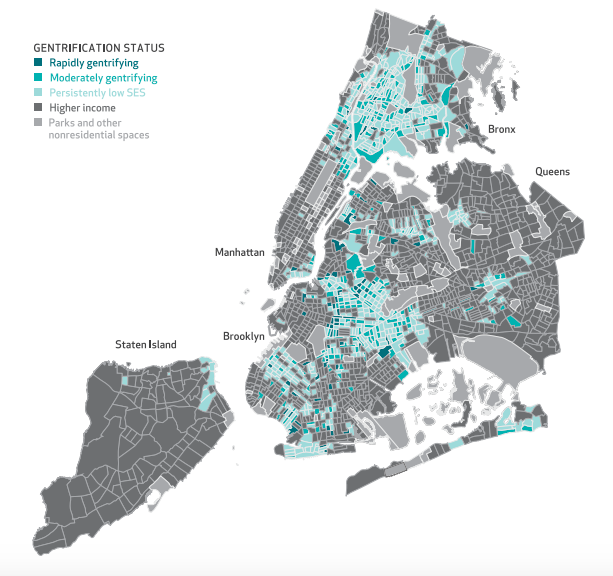Connecting state and local government leaders
Neighborhood change brings both positive and negative effects on existing residents. Among the latter: a newfound link to anxiety and depression in kids.
Neighborhoods are a powerful force in the life of a child. Kids who grow up in areas with more opportunities wind up with better mental health and economic prospects, long-term gains that guide their outcomes as adults. And children who remain in place as their neighborhoods undergo demographic shifts that bring in more higher-income residents stand to reap the opportunity benefits.
But there may be at least one health drawback to growing up amidst gentrification. In New York City, low-income children born into neighborhoods that have seen growing numbers of college-educated and affluent newcomers were more likely to be diagnosed with anxiety or depression than poor children who grew up in places that didn’t gentrify.
This anxiety connection adds a new dimension to discussions about the health benefits associated with growing up in areas with more opportunity, according to a researchers at New York University. But the study didn’t find any link between gentrification and disorders that are much more prevalent among low-income children: obesity, asthma, and attention deficit–hyperactivity disorder.
“We see it as a red flag,” says Ingrid Gould Ellen, professor of urban policy and planning and director of NYU’s Furman Center for Real Estate and Urban Policy. “It might be that gentrification is bringing changes to neighborhoods that make original residents feel like they no longer belong in those neighborhoods, which makes kids feel uncomfortable and anxious. That is something to watch out for.”
The NYU researchers used a novel dataset to follow health outcomes of children: New York City’s Medicaid database. The study focuses on children born in the city’s low-income neighborhoods between 2006 and 2008. Using Medicaid data, the researchers tracked the paths of these children from January 2009 to December 2015. The extraordinarily detailed data show where families live, down to the building-level, which enables researchers to look at neighborhood change as a factor in children’s lives.
The latest research, published in September in Health Affairs, builds upon previous work by the researchers using Medicaid data in New York. A prior study showed that low-income children born into gentrifying areas were no more likely to be displaced than kids born in places that showed persistently low socioeconomic status.
Researchers can’t point to the exact mechanism that’s behind the statistically significant increase in anxiety and depression among kids. Critics of gentrification will say it’s laughably obvious, but the data don’t show what it is about gentrification, exactly, that is stressful to children living in these neighborhoods. The researchers do have reason to believe that the anxiety is indeed economic in nature: One subset of children who stayed in gentrifying neighborhoods—those with housing subsidies—did not see an uptick in anxiety, suggesting that insecurity may be the culprit.

“These kids, their anxiety levels, might be affected by the changes that are going on all around them,” says Gould Ellen. She conducted the study with Sherry Glied, health economist and dean of NYU’s Robert F. Wagner Graduate School of Public Service, and Kacie Dragan, a doctoral student at Harvard University and until recently project manager for NYU’s Policies for Action Research Hub.
Medicaid data offers a whole host of health outcomes that the researchers might have tracked. The NYU study focuses on a handful that are most likely to be linked to neighborhood change. Gould Ellen says that they restricted their search to the factors used for a 10-year demonstration conducted by the U.S. Department of Housing and Urban Development in the 1990s. This experiment, called Moving to Opportunity, showed that children of families who used Section 8 housing vouchers to move into better neighborhoods enjoyed a number of material health and economic benefits.
So the researchers looked at the same four factors or outcomes: obesity, asthma, anxiety or depression, and ADHD conduct disorder. Growing up in a rapidly gentrifying neighborhood did not have any effect on any of those outcomes except one: anxiety or depression. Children born into rapidly gentrifying neighborhoods saw a 1.6 percent increase in anxiety relative to those who lived in low-income neighborhoods that didn’t gentrify (8.7 versus 7.1 percent).
Beyond the major childhood disorders, there was no link in New York between neighborhood change and hospitalizations or emergency room visits, either. These figures were (shockingly) high across the board: Children born into low-income neighborhoods in New York all relied on the emergency room for routine healthcare.
Using other definitions for gentrification, including changes in average income or rise in average rents, the researchers found that this correlation was still positive and unique. And the effect of gentrification on childhood anxiety was significant for both boys and girls, and for both black children and white children.
The latest findings merit a word of caution. In absolute terms, the number of children diagnosed with anxiety or depression are low. While the increase is statistically significant, the incidence of childhood anxiety is nowhere near as severe a problem as childhood obesity or asthma. Over the longer term, childhood anxiety or depression might go away—or these disorders might manifest as more difficult or dangerous disorders for adults later.
“We only were able to look at kids through to the ages of 9 to 11,” Gould Ellen says. “When the Moving to Opportunity program looked at [five-year] impacts on children’s health, they really didn’t see any impacts on kids’ health in the short run. But in the long run they found these dramatic benefits for kids who had grown up in low-poverty neighborhoods.”
She adds, “Kids tend to be relatively healthy and resilient. It could be, in the longer run, health effects might emerge that we just aren’t perceiving now.”
Critics and defenders of gentrification alike see evidence for their case in the health outcomes for families. On the one hand, areas with greater opportunity are linked to better mental health and long-term benefits for children as they grow into adulthood. Low-income children who are able to stay in gentrifying neighborhoods—and that’s most low-income children—face lower exposure to poverty, which pays off in terms of physical health, mental health, and sense of satisfaction in life.
On the other hand, gentrification may be disruptive to children. Parents might lose reliable access to childcare or healthcare providers as neighborhoods change. They might worry about rising costs of living or suffer greater burdens even if they aren’t displaced. Especially when families are pushed to choose lower quality housing in order to stay, children may suffer. And kids see change happening around them, too.
One constant across both of these recent NYU studies of New York’s Medicaid database: Section 8 works. Children living in families who receive housing subsidies have more security. Low-income families with housing aid suffered less displacement than low-income families living in market-rate housing. And low-income children with housing aid suffered less anxiety as a result of gentrification than low-income children living in market-rate housing. Those are huge findings that should guide policy debates about alleviating poverty and expanding opportunity.
This research is another argument in favor of increasing housing aid and making housing aid work better. It lines up with a recent Seattle experiment on Section 8 by Raj Chetty’s Opportunity Insights team that showed that more families chose to use housing vouchers to move to higher opportunity neighborhoods when they received info about the benefits (and when landlords got some coaching, too).
The new research joins prior studies on neighborhood change that paint a complex picture of gentrification. Previously, Gould Ellen showed that public housing residents in gentrifying areas benefit from greater resources even as they feel stress about the changes taking shape around them. Cultural erasure could be linked to the red flag of childhood anxiety; families who might benefit from change may still feel anxious about it. The case against gentrification is not an open-and-shut one.
“We’re not seeing a lot of strong support for either the optimist or the pessimist case,” Gould Ellen says. “Our results show that it’s more nuanced than it’s often assumed.”
Kriston Capps is a staff writer for CityLab covering housing, architecture, and politics

NEXT STORY: Fur Clothing Bans Advance in More Cities and States



